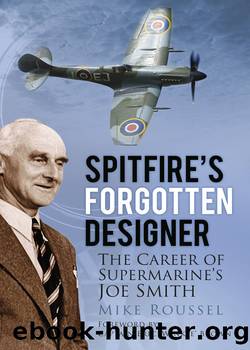Spitfire's Forgotten Designer by Mike Roussel

Author:Mike Roussel
Language: eng
Format: epub
ISBN: 9780752492407
Publisher: The History Press
Published: 2013-03-08T00:00:00+00:00
Increasing Fuel Capacity
The original Spitfire was designed as an interceptor, operating from home bases and attacking German aircraft when they flew over the coast on the way to their pre-planned targets. At that time, the Spitfire carried a fuel capacity that allowed a limited time in the air, but being able to land in order to refuel and rearm and then be back in the air to continue the battle served its purpose. However, as well as the requirement for increased armaments there was now a need to carry extra fuel for increasing the range of the fighters. This was gained by creating space for carrying fuel in extra tanks behind the cockpit, and also carrying fuel in the leading edges of the wing together with the use of a drop tank.
In the later versions of the fighter, extra fuel tanks were carried in self-sealing tanks in the wing root leading edges. These should not be confused with the PR variants. It is helpful to recall that the nomenclature of the PR variants had no relation to the fighter variants; for example, the PR Mk IV was basically the F Mk I or later Mk V, whereas the Mk IV was the prototype of the Griffon engine installation and became the production Spitfire F Mk XII. The two Griffon engine installations in the Mk III airframe were numbered DP845 and DP851 and were given the nickname by the test pilots as the âleaner backersâ due to their very high rate of climb.
Download
This site does not store any files on its server. We only index and link to content provided by other sites. Please contact the content providers to delete copyright contents if any and email us, we'll remove relevant links or contents immediately.
Kathy Andrews Collection by Kathy Andrews(11763)
The remains of the day by Kazuo Ishiguro(8887)
Spare by Prince Harry The Duke of Sussex(5138)
Paper Towns by Green John(5136)
The Body: A Guide for Occupants by Bill Bryson(5027)
Industrial Automation from Scratch: A hands-on guide to using sensors, actuators, PLCs, HMIs, and SCADA to automate industrial processes by Olushola Akande(5024)
Machine Learning at Scale with H2O by Gregory Keys | David Whiting(4258)
Be in a Treehouse by Pete Nelson(3996)
Never by Ken Follett(3877)
Harry Potter and the Goblet Of Fire by J.K. Rowling(3806)
Goodbye Paradise(3760)
Into Thin Air by Jon Krakauer(3346)
The Remains of the Day by Kazuo Ishiguro(3343)
Fairy Tale by Stephen King(3306)
The Cellar by Natasha Preston(3296)
The Genius of Japanese Carpentry by Azby Brown(3254)
120 Days of Sodom by Marquis de Sade(3223)
The Man Who Died Twice by Richard Osman(3040)
Drawing Shortcuts: Developing Quick Drawing Skills Using Today's Technology by Leggitt Jim(3036)
